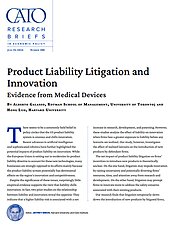Despite the significance of these issues, surprisingly little empirical evidence supports the view that liability chills innovation. In fact, two prior studies on the relationship between liability and innovation reveal the opposite: They indicate that a higher liability risk is associated with a net increase in research, development, and patenting. However, these studies analyze the effect of liability on innovation when firms face a greater exposure to liability before any lawsuits are realized. Our study, however, investigates the effect of realized lawsuits on the introduction of new products by defendant firms.
The net impact of product liability litigation on firms’ incentives to introduce new products is theoretically unclear. On the one hand, litigation may impede innovation by raising uncertainty and potentially diverting firms’ resources, time, and attention away from research and development. On the other hand, litigation may prompt firms to innovate more to address the safety concerns associated with their existing products.
Our research finds that litigation temporarily slows down the introduction of new products by litigated firms, but only for the specific product categories that are being litigated. Furthermore, our findings indicate that litigation is associated with an improvement in product safety.
Our research focuses on the medical device sector, which is research-intensive, has a significant impact on social well-being, and experiences a high number of product liability lawsuits. Additionally, this industry is subject to safety regulation by the US Food and Drug Administration (FDA). This allows us to examine the potential interaction between regulation policies and the product liability system.
We constructed a dataset that includes information on new product introductions and product liability litigation for 45 leading medical device firms from 1995 to 2020. The FDA provided application data to measure new product introductions, while the Judicial Panel on Multidistrict Litigation supplied the litigation data. Multidistrict litigation is a procedure designed to efficiently process cases involving numerous plaintiffs in multiple states with shared issues. Multidistrict litigation cases thus encompass the most significant product liability lawsuits related to products sold nationwide to consumers. Our dataset includes 37 unique multidistrict litigations involving 16 firms, covering a total of 215,483 individual cases.
Our research finds that defendant firms experience a decline of approximately 40 percent in the rate at which they introduce new products in the litigated product categories while the litigation is ongoing, which typically lasts for about seven years. Nondefendant firms operating in the litigated product categories also experienced a slowdown in their new product introductions, though to a lesser extent. But this decline is not permanent, as new product introductions in the litigated categories recover shortly once the litigation concludes. Moreover, our research does not indicate any slowdown in firms’ patenting activities due to litigation. Importantly, contrary to concerns expressed by industry observers, our findings do not demonstrate a decrease in the number of new products being introduced in other product categories, even those closely related to the litigated categories in terms of technology.
Our study also examines the impact of safety regulation on product liability litigation by examining two policy changes. The first policy change relates to the disclosure of reports on adverse events associated with a product to the public. The FDA assesses a product’s safety by collecting information from manufacturers and health care providers about adverse events linked to device usage. The agency typically discloses these events in a publicly accessible database. However, KFF Health News reported in 2019 that the FDA had established a separate reporting system that collected adverse event reports associated with 100 product categories between 1999 and 2019 but never made this repository public. By utilizing the adverse event data from both the hidden database and the publicly accessible database, our research demonstrates that the transparency of such information significantly affects the likelihood of litigation. Further analysis confirms the negative relationship between litigation and new product introductions.
The second policy change is the Supreme Court’s 2008 ruling in Riegel v. Medtronic Inc. This ruling clarified that products that have undergone the FDA’s premarket approval process—the most stringent review process for medical devices—should not be subject to state product liability lawsuits. Our research shows a decline in litigation against premarket-approved devices after 2008, preventing any decrease in the introduction of new products associated with litigation.
Finally, our research investigates whether litigation encourages the development of safer devices. To measure safety, we used two indicators: one based on the number and severity of reported adverse events for a device and the other based on patent text data to determine if a patent addresses safety-related problems. Our findings provide evidence that products introduced after litigation are associated with fewer and less severe adverse events compared with those introduced beforehand and that litigated firms appear to allocate more resources to safety-related technologies.
Our results contribute valuable empirical evidence to the ongoing debates surrounding product liability and innovation. Our core finding is that litigation events in the medical device industry substantially slow down the introduction of new products when litigation is ongoing. Assessing the impact on social welfare is challenging because some negative consequences for defendant firms are necessary to deter the production of defective products. However, our research mitigates concerns about the overall negative impact of product liability litigation on innovation. Contrary to the worries about widespread chilling effects, the negative impact is temporary and restricted to the specific product categories involved in litigation, with no declines in patent activity. Additionally, litigation is associated with improvements in product safety, which is the key objective of the liability system.
NOTE
This research brief is based on Alberto Galasso and Hong Luo, “Product Liability Litigation and Innovation: Evidence from Medical Devices,” National Bureau of Economic Research Working Paper no. 32215, March 2024.

